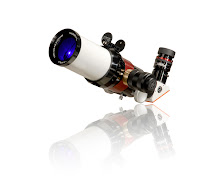 The diagram at left shows the system has been fully pressurized. This pressure is equivalent to about a 12,000ft altitude change.
The diagram at left shows the system has been fully pressurized. This pressure is equivalent to about a 12,000ft altitude change.The air inside the sealed chamber has been compressed due to the reduced volume. As a result the refractive index of the air has increased and caused the CWL of the etalon to move to the blue or high energy side of the Hydrogen wavelength.
Due to the fact that there is no tilt involved, the image field remains flat and very precise.
Traditional tilting allows the Doppler shifting across the field in a plane perpendicular to the axis of light. The user can see a change to the image that allows for the viewing of proms and then filaments. The optimum position is when the proms and surface are both fairly detailed. Overtilting will tighten the bandpass but will also produce a banding effect. The resolution under the band is higher, but at the expense of the entire field of view.
People often feel that the entire field should be as good as the area created under the band. If this were possible, the systems would be spec'd at a much lower bandpass. If a band occurs, the system has probably been over attenuated.
True Doppler Tuning allows for a shift into and away from the user. Adding a 3D component to the viewing experience.
While it has minimal effect on proms due to their being at the edge of the disk, it does have an effect on filaments and active regions.
While looking at a filament at the center of the Sun the user has the ability to Doppler shift from the base of the filament to the tip, following the filament thru it's structure toward you and away from you. Allowing for enhanced visual and imaging capability for the observer as well as a research tool for the avid hobbyist.
The tuning system provides an order of magnitude more precision to the tuning of the desired features.
We are working on designs to the LS100F and the LS100T/Na utilizing the same technology.
The LS100F will be remotely operated for those that have this filter mounted on a long FL scope and do not have 4ft long arms.
We are currently manufacturing the LS60T and the LS100T via this technology.
The LS60T is fully upgradeable to the new Pressure Tune System at any time. However, it does require a return to the factory.
End of Part 3

No comments:
Post a Comment